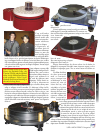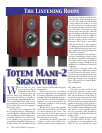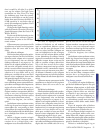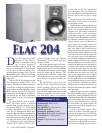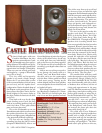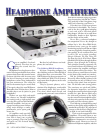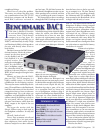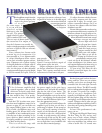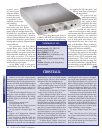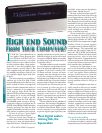
Feedback
Listening Room
getting the tone wrong on a couple of the
really large drums. But because the bass
response is necessarily limited, the prob-
lem wasn’t more than detectable. Much
more noticeable was the furious rhythm
and the energy. That odd scraped gourd
in the introduction came on with power,
and so did the whistle. The kick drum,
which some speakers simply ignore
(perhaps fortunately), was surprisingly
good. So was Feldman’s piano.
We were curious to see how the
Castle Richmonds would do on our usual
battery of technical tests. We began by
drawing its impedance curve, which is
shown in the graph above. Despite the
claim of an 8 ohm impedance, the curve
actually gets rather closer to 4 ohms
over an important part of the range,
and considerably below 4 ohms at high
frequency.
We set up our precision calibrated
microphone 1 m in front of the Rich-
mond, but weren’t certain how we
should orient it. We usually position it
on axis with the tweeter, but the inverted
configuration of the speaker places the
tweeter rather low. We finally put it
at woofer height, but slanted down so
that it pointed toward the tweeter. The
resulting frequency response curve (top
right), is very good, especially through
the upper midrange and the top end, The
waviness in the lower part of the band is,
as usual, due to room modes. Of course
there’s not much in the way of very
low bass. Clean response mostly ends
at 50 Hz, and even then the waveform
(second image at right) isn’t really clean.
Below that you’ll hear sound, but not the
fundamental tone.
The 100 Hz square wave (bottom
right) is quite good, with barely a glitch
on the riser, and a funny little lateral
wave almost certainly caused by distor-
tion in the bass. But then we do test at
high levels: 100 dB reference level at that
1 m distance.
By the usual high end standards,
these are low-cost speakers. They prob-
ably won’t be the cheapest in the store,
however, and people not used to high end
gear may find their gaze wandering over
to speakers half the price and triple the
size. But you’re buying music, not scrap
iron. For a price most people can either
pay or save up for in a reasonable time,
they’ll amply justify buying something
other than a mini system.
Too bad they’re not available in
fivepacks. We were thinking that you
could add a subwoofer and you’d have a
home theatre system that would make
your home-theatre-in-a-box neighbors
green with envy.
In an ideal hi-fi world speakers would
all be affordable and equally suited to re-
producing all types of music effortlessly. In
the real world, many speakers strain with
the task of handling the weight of complex
music. This one was no exception.
Choosing a pair of speakers is often a
sum of compromises, and, in this case you'd
best limit your music listening to smaller
groups, with or without voices. You'll ac
-
tually be happily surprised, as I was, with
these speakers' ability to deliver a clearly-
defined image, and the solid, palpable pres
-
ence of each performer.
—Albert Simon
This is a
much smaller speaker than any
Castle we had ever tested, but its consider
-
able virtues make it a worthy member of a
distinguished family.
No
of course it can’t play a full orchestra
at realistic volume.
Of course it can’t repro-
duce kettle drums and plucked basses real
-
istically. But what it
can handle it handles
with aplomb. It has none of the grey opaque
sound of too many inexpensive speakers. It
plays music, for real.
I was bemused by the quality touches
Castle has provided even at this price. The
terrific wood finish for one. The curved
grille (best left off, as usual) for another.
And have you noticed that they went to the
expense of making right-left mirror image
speakers?
This is a class act all the way.
—Gerard Rejskind
Despite their modest price these little
speakers can give their owners a lot of plea
-
sure. Find a volume level they’re comfort
-
able with, and you can start to discover their
numerous assets. I’m talking about image,
depth and width, all of which are perfectly
acceptable. If the bottom end could use a
little more weight, the midrange is very
good and gives the music considerable rich
-
ness. The sensitivity of the musicians, heard
through these speakers, is contagious.
Add to that a multitude of details, good
inflection, lyrics you can always follow.
These qualities make you forget, or at least
forgive, an occasional hardening here and
there, and perhaps a bit of drag on certain
rhythms.
On the æsthetic side, you can hardly
help noticing the refined wood finish that
invites you to touch them, to appreciate
their satin smoothness. These cabinets
were made by artists, not mere laborers.
—Reine Lessard
CROSSTALK
ULTRA HIGH FIDELITY Magazine 37



